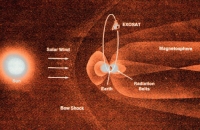Summary
 |
|
EXOSAT orbit |
EXOSAT was also unusual at the time because it featured an onboard computer. This not only processed much of the data before returning it to Earth, but also allowed scientists to alter the on-board data handling programs after launch, making EXOSAT much more flexible. Scientists now had more freedom to investigate results that had not been expected at the time of the launch.
The satellite's payload consisted of three instruments:
- two low energy telescopes
- the medium energy proportional counter
- a gas scintillation proportional counter
These experiments were complimentary, and together gave EXOSAT a wide range, between 0.05-50 keV, in which to take readings.
The first 8 weeks after launch were dedicated to a performance verification phase. After this the regular guest observer program was undertaken. By the end of the operational phase four announcements of opportunity had been made with 98%, 94%, 64% and 18% of each program completed. During the 3 years of operations, scientists around the world used EXOSAT to study most classes of X-ray sources and made many new discoveries. Perhaps the most notable were the discovery of quasi-periodic oscillations (QPO) from low mass X-ray binaries (LMXRB), soft excesses from Active Galactic Nuceli (AGN), the red and blue shifted iron K line from SS433, many orbital periods from low mass X-ray binaries, and several new transient sources. The public availability of these data contributed to many notable systematic studies of individual classes and the archive continues to be heavily used and is still yielding new results.
The EXOSAT project was also the forerunner of current X-ray telescopes such as ESA's XMM-Newton and NASA's Chandra satellite. These satellites work on very similar principles to EXOSAT, and due to new technology, are able to take more accurate readings.
